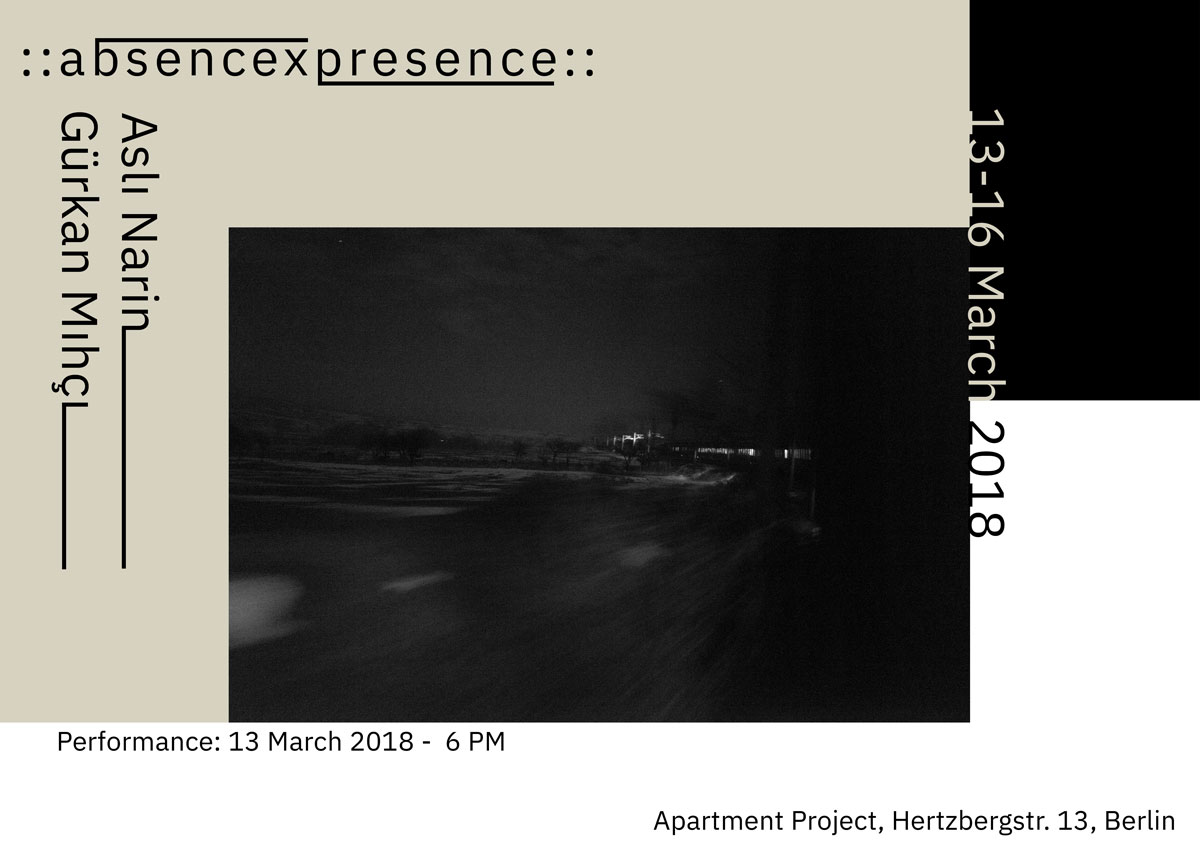absencexpresence
absencexpresence Asli Narin & Gurkan Mihci
Audio Visual Performance and Exhibition
“absencexpresence” focuses on Asli Narin’s and Gürkan Mıhçı’s 24-hour-experience on Eastern Express train journey, from Ankara to Kars. They took off with the intention of collaboration and art production. As Maurice Merleau-Ponty claims that the painter changes the world into paintings by lending his body to the world*, Asli Narin and Gurkan Mihci takes this phenomena to its maximum in their collaboration.
This one day self-held residency under the name of “Moving Atelier” which was a project found by Asli Narin and continued later on with other projects, questions the effects of constant motion and the limitation of time and space in art production. Lawrence Weschler aims this kind of production method “radical self limitation” and discusses its positive effects for new works for artists*. In this experimental situation, the train became both the studio and the material for the artists. By recording both sound and image constantly and separate from each other, the artists’ aim was to create a mutual/joint body of work of their experience of the train journey.
Ponty depicts that we should understand the body not as a space or a device with functions; we should look at it as an intertwining of vision and movement. While the window of the train served as a screen for moving frames, the mechanics of the train served as sound sources. Two separate movements were accomplished: The train and the bodies of the artists. This chaotic environment that they were in can be realized as the undividedness of the sensing and the sensed in Ponty’s words.
In their audiovisual show, the artists perform their experience of the one-day cycle, which mostly took their attention. Taking the inspiration from the changes of the mood-especially with the light- between the day and the night journey, the show is an spontaneous abstraction of these moods and feelings. Immersed in constant motion, their bodies were exposed to many sounds and images in flux. This flux is taken in fragments and converted into sound and image compositions in a new flow.
*Weschler, Lawrence, The Sense of Movement, 2015
**Merleau-Ponty, Maurice, Eye and Mind, 1961
Artists:
Asli Narin (1985, Istanbul) received her Bachelor of Arts degree from Visual Arts and Visual Communication Design Department at Sabanci University (2008) and her Master of Arts degree at Goldsmiths University of London (2009). She has been attending many group exhibitions since 2008. In 2010, her works were selected for “Young, New and Different” exhibition of Casa Dell Arte Gallery and Istanbul Modern Museum Photography Collection. Since then, she had two solo exhibitions in Kasa Gallery (2014, Istanbul, Turkey) and Oktem&Aykut Gallery (2015, Istanbul, Turkey). She has been participating at several exhibitions all around the world, including After Yesterday, Istanbul Museum Photography Collection (Istanbul, Turkey 2012), Acting In The Library, 1st Tbilisi Triennial-Offside Effect, (Tbilisi, Georgia. 2012), Istanbul Modern-Bahrain, Bahrain National Museum, (Bahrain, 2013), Editions III, Elipsis Gallery, (Istanbul, Turkey 2013), Second Eye-Women Photographers from Turkey, Sismanoglio Megaro, (Istanbul, Turkey, 2013), Reunion, Sakip Sabanci Museum, (Istanbul, Turkey, 2015), Things that Count…Things That Don’t, The Abrazo Interno Gallery (New York, USA, 2015) and CICA Contemporary Photography Exhibition Summer/Fall 2016, CICA Museum (Gyeonggi-do, South Korea. 2016), Imago Mundi -Mediterranean Routes, Group Exhibition, Zona Arti Contemporanee (Palermo, Italy, 2017), The Photobook Exhibition-Athens Photo Festival, Group Exhibition, Benaki Museum (Athens, Greece, 2017). Besides, she was invited for prestigious artist residency projects in Turkey such as Greenpeace Rainbow Warrior Ship and Gumusluk Academy. Currently, she teaches photography and design courses at Kadir Has University Visual Communication Design Department, while pursuing her doctoral degree at Yildiz Technical University.
Gurkan Mihci (1980, Ankara), is an assistant professor at IUPUI Herron Art and Design. After having his B.F.A. degree in Graphic Design (Bilkent University), he continued his studies in Visual Arts and Visual Communication Design (M.A.) (Sabanci University) with the concentration in Audio Visual Noise and Glitch Aesthetics. He has been teaching audio visual communication design courses for 9 years. He had a solo exhibition in Marquis Projects, Izmir, Turkey-June 2014 and e exhibited his collective and individual audio visual art and media works in festivals and exhibitions worldwide such as; Radio Zero Festival; Porto, Portugal, Monsters International; Montreal, Canada, Animatu Digital Animation Festival; Portugal, Conde Duque; Madrid, Spain, Mestre Film Fest; Venice, Italy, FILE – Electronic Language Festival; Sao Paulo, Brazil, 0090; Antwerp-Mechelen, Belgium, Akbank Art Contemporary Artist Competition and Greenpeace Artist On Board. He is also a member of World Forum for Acoustic Ecology.
Weschler, Lawrence, The Sense of Movement, 2016
Merleau-Ponty, Maurice, Eye and Mind, 1961
yoklukxmevcut
Asli Narin & Gurkan Mihci
Görsel İşitsel Performans ve Sergi
yoklukxmevcut, Aslı Narin ve Gürkan Mıhçı’nın Ankara’dan Kars’a giden Doğu Ekspresi’nde geçirdiği 24 saatlik deneyime odaklanıyor. Sanatçılar bu seyahate iş birliği içinde sanat üretmek için çıktılar. 2017 Şubat tarihinde gerçekleşen bu iş üretme deneyinde Aslı Narin ve Gürkan Mıhçı, bu işbirliklerinde Maurie Merleau Ponty’nin ressamın kendi bedenini dünyaya adayarak dünyayı resimleriyle değiştirdiği olgusunu farklı bir şekilde yorumladılar (Ponty, 1961).
Aslı Narin’nin “Moving Atelier” adı altında gerçekleştirdiği tek günlük sanatçı misafir programının ve daha sonra 2 farklı projeyle daha devam etmiş fikrin amacı, devamlı hareket halinin yanı sıra zamanın ve alanın limitlerin sanat üretimindeki etkilerini sorgulamaktır. Lawrence Weschler bu gibi üretim metotlarına “kendini radikal bir şekilde sınırlamak” olarak adlandırır ve bunun sanatçıların işlerinde pozitif etkilerinin olacağını söyler (Weschler, 2015). Bu deneysel durumda tren, sanatçıların hem stüdyosu hem de sanat işinin ham maddesi haline gelmektedir. Sanatçıların amacı, sesi ve imgeyi bir süreklilik halinde beraber veya birbirinden ayrı kayıt altına alarak, tren yolculuğundaki deneyimlerini müşterek bir sanat işi olarak yansıtmaktı.
Ponty, bedeni bir alan veya fonksiyonel araç olarak değil, birbiri içine sarmanlanmış görüş ve hareket olarak yorumlamamız gerektiğini söylüyor (Ponty, 1961). Bu deneysel proje denemesinde de iki ayrı hareket; sanatçıların bedenleri ve tren, birbirleri içine sarmanlanmış oldular. Yolculuk boyunca trenin pencereleri hareketli kareler olarak bir görüntü imkanı olurken trenin mekaniği ise ses olarak bir başka bir arşiv imkanı verdi. Sanatçıların içinde bulunduğu bu kaotik ortam Ponty’nin deyimiyle duyunun ve duyumsanılanın bölünmezliğinin temsili denebilir.
Deneyimin sonucunda ortaya çıkan görsel işitsel performanslarında sanatçılar, bir günlük döngü sırasında yaşadıkları deneyimleri sunuyorlar. Performans, yolculuk sırasındaki anlık hissiyatlardan, özellikle ışığın ve gece ve gündüz arasındaki değişimlerin verdiği ilham ile şekilleniyor. Sürekli hareket halindeki sanatçıların bedenleri durmaksızın bir ses ve imge akışına maruz kalırken yaşadıkları akışı parçalara bölerek yeni bir akış içerisinde görsel ve işitsel bir kompozisyona dönüştürüyorlar.
Weschler, Lawrence, The Sense of Movement, 2015
Merleau-Ponty, Maurice, Eye and Mind, 1961


